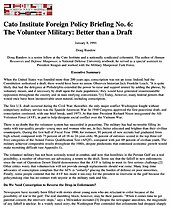When the United States was founded more than 200 years ago, conscription was not an issue. Indeed, had the Constitution authorized a draft, there would have been no union. Observes historian Jack Franklin Leach, “It is quite likely that had the delegates at Philadelphia extended the power ‘to raise and support armies’ by adding the phrase, ‘by voluntary means, and if necessary by draft upon the male population,’ they would have generated insurmountable opposition throughout the country and in state ratifying conventions.”[1] Today, however, many federal powers that would once have been inconceivable seem natural, including conscription.
The first U.S. draft occurred during the Civil War; thereafter, the only major conflict Washington fought without compulsory military service was the Spanish American War. In 1940 Congress approved the first peacetime draft, and conscription continued, with one brief break, until 1973. At that time President Richard Nixon inaugurated the All-Volunteer Force (AVF), in part to help dissipate social conflict over the Vietnam War.
There is no doubt that the volunteer system has succeeded in peacetime. The military has had no trouble filling its ranks with top-quality people–young men and woman who are, in fact, better educated and brighter than their civilian counterparts. During the first half of Fiscal Year 1990, for instance, 91 percent of new recruits had graduated from high school, compared with 75 percent of all 18-to 24-year-olds; 96 percent of enlistees scored in the top three (of five) categories of the Armed Forces Qualification Test (AFQT), compared with just 69 percent of civilian youth. The military achieved comparable results throughout the 1980s, despite predictions that continued economic growth would make recruiting difficult (see Appendix 1).
The volunteer military has not been seriously tested in combat, and now that hostilities in the Persian Gulf are a real possibility, a number of observers are advocating a return to the draft. Some say that the falloff in new enlistments since the start of Operation Desert Shield demonstrates that the AVF is failing to meet its first serious challenge.[2] Other critics worry that volunteerism will not provide enough replacements should war come. Many long-time advocates of conscription complain that the AFV is “unfairly” placing the burden of defense on poor minorities. Finally, some people contend that the AVF has made it too easy for the president to intervene in the gulf because the policymaking elite has no contact with anyone in the military rank and file.

This work is licensed under a Creative Commons Attribution-NonCommercial-ShareAlike 4.0 International License.

